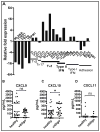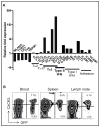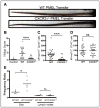CXCL10 is critical for the progression and maintenance of depigmentation in a mouse model of vitiligo
- PMID: 24523323
- PMCID: PMC4086941
- DOI: 10.1126/scitranslmed.3007811
CXCL10 is critical for the progression and maintenance of depigmentation in a mouse model of vitiligo
Abstract
Vitiligo is an autoimmune disease of the skin that results in disfiguring white spots. There are no U.S. Food and Drug Administration-approved treatments for vitiligo, and most off-label treatments yield unsatisfactory results. Vitiligo patients have increased numbers of autoreactive, melanocyte-specific CD8(+) T cells in the skin and blood, which are directly responsible for melanocyte destruction. We report that gene expression in lesional skin from vitiligo patients revealed an interferon-γ (IFN-γ)-specific signature, including the chemokine CXCL10. CXCL10 was elevated in both vitiligo patient skin and serum, and CXCR3, its receptor, was expressed on pathogenic T cells. To address the function of CXCL10 in vitiligo, we used a mouse model of disease that also exhibited an IFN-γ-specific gene signature, expression of CXCL10 in the skin, and up-regulation of CXCR3 on antigen-specific T cells. Mice that received Cxcr3(-/-) T cells developed minimal depigmentation, as did mice lacking Cxcl10 or treated with CXCL10-neutralizing antibody. CXCL9 promoted autoreactive T cell global recruitment to the skin but not effector function, whereas CXCL10 was required for effector function and localization within the skin. Surprisingly, CXCL10 neutralization in mice with established, widespread depigmentation induces reversal of disease, evidenced by repigmentation. These data identify a critical role for CXCL10 in both the progression and maintenance of vitiligo and thereby support inhibiting CXCL10 as a targeted treatment strategy.
Conflict of interest statement
Figures






Similar articles
-
Increased expression of CXCR3 and its ligands in patients with vitiligo and CXCL10 as a potential clinical marker for vitiligo.Br J Dermatol. 2016 Jun;174(6):1318-26. doi: 10.1111/bjd.14416. Epub 2016 May 4. Br J Dermatol. 2016. PMID: 26801009
-
Simvastatin prevents and reverses depigmentation in a mouse model of vitiligo.J Invest Dermatol. 2015 Apr;135(4):1080-1088. doi: 10.1038/jid.2014.529. Epub 2014 Dec 18. J Invest Dermatol. 2015. PMID: 25521459 Free PMC article.
-
Suction blistering the lesional skin of vitiligo patients reveals useful biomarkers of disease activity.J Am Acad Dermatol. 2017 May;76(5):847-855.e5. doi: 10.1016/j.jaad.2016.12.021. Epub 2017 Mar 1. J Am Acad Dermatol. 2017. PMID: 28259440 Free PMC article.
-
The IFN-γ-CXCL9/CXCL10-CXCR3 axis in vitiligo: Pathological mechanism and treatment.Eur J Immunol. 2024 Apr;54(4):e2250281. doi: 10.1002/eji.202250281. Epub 2024 Mar 5. Eur J Immunol. 2024. PMID: 37937817 Review.
-
CXCR3 Ligands in Cancer and Autoimmunity, Chemoattraction of Effector T Cells, and Beyond.Front Immunol. 2020 May 29;11:976. doi: 10.3389/fimmu.2020.00976. eCollection 2020. Front Immunol. 2020. PMID: 32547545 Free PMC article. Review.
Cited by
-
Role of Cytokines and Chemokines in Vitiligo and Their Therapeutic Implications.J Clin Med. 2024 Aug 20;13(16):4919. doi: 10.3390/jcm13164919. J Clin Med. 2024. PMID: 39201060 Free PMC article. Review.
-
Vitiligo, From Physiopathology to Emerging Treatments: A Review.Dermatol Ther (Heidelb). 2020 Dec;10(6):1185-1198. doi: 10.1007/s13555-020-00447-y. Epub 2020 Sep 19. Dermatol Ther (Heidelb). 2020. PMID: 32949337 Free PMC article. Review.
-
Regenerative Medicine-Based Treatment for Vitiligo: An Overview.Biomedicines. 2022 Oct 28;10(11):2744. doi: 10.3390/biomedicines10112744. Biomedicines. 2022. PMID: 36359263 Free PMC article. Review.
-
Skin Interstitial Fluid and Plasma Multiplex Cytokine Analysis Reveals IFN-γ Signatures and Granzyme B as Useful Biomarker for Activity, Severity and Prognosis Assessment in Vitiligo.Front Immunol. 2022 Apr 7;13:872458. doi: 10.3389/fimmu.2022.872458. eCollection 2022. Front Immunol. 2022. PMID: 35464413 Free PMC article.
-
Vitiligo, from Pathogenesis to Therapeutic Advances: State of the Art.Int J Mol Sci. 2023 Mar 3;24(5):4910. doi: 10.3390/ijms24054910. Int J Mol Sci. 2023. PMID: 36902341 Free PMC article. Review.
References
-
- Taieb A, Picardo M. Clinical practice. Vitiligo. N Engl J Med. 2009;360:160–169. - PubMed
-
- Passeron T, Ortonne JP. Activation of the unfolded protein response in vitiligo: the missing link? J Invest Dermatol. 2012;132:2502–2504. - PubMed
-
- Shah AA, Sinha AA. Oxidative stress and autoimmune skin disease. Eur J Dermatol. 2013;23:5–13. - PubMed
-
- Laddha NC, Dwivedi M, Mansuri MS, Gani AR, Ansarullah M, Ramachandran AV, Dalai S, Begum R. Vitiligo: interplay between oxidative stress and immune system. Exp Dermatol. 2013;22:245–250. - PubMed
-
- van den Boorn JG, Melief CJ, Luiten RM. Monobenzone-induced depigmentation: from enzymatic blockade to autoimmunity. Pigment cell & melanoma research. 2011;24:673–679. - PubMed
Publication types
MeSH terms
Substances
Associated data
- Actions
Grants and funding
LinkOut - more resources
Full Text Sources
Other Literature Sources
Medical
Molecular Biology Databases
Research Materials

